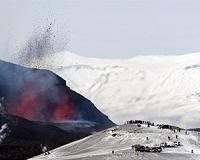| . |  |
. |
London, UK (SPX) May 11, 2010 A scientific team led by Dr Peter Talling of the UK's National Oceanography Centre (NOC) is currently aboard the Royal Research Ship James Cook to map extremely large landslide deposits offshore from an active volcano on Montserrat in the Lesser Antilles. The volcano has been erupting episodically since 1995, with the last major eruption and volcanic dome collapse occurring in February 2010. Previous eruptions on the island have included the largest volcanic dome collapses ever documented. These eruptions were monitored on land, and marine surveys showed what happens when the hot volcanic flows enter the ocean. Thousands of years ago, far larger collapses of the entire volcanic edifice occurred sending huge landslides into the ocean to the east and south of the island. Some of these landslides involved over five cubic kilometres of material and travelled underwater for tens of kilometres. They were much larger than even the largest of the volcanic dome collapses since 1995 and probably generated tsunamis, whose magnitude is uncertain. "We plan to produce the first detailed survey of this type of volcanic flank collapse deposit," said Dr Talling: "For the first time, we will image flank collapse deposits by collecting three-dimensional seismic reflection data, which will show how huge avalanches were emplaced." The researchers wish to learn if landslides from the volcano that are violently emplaced on the seafloor can trigger even larger-scale failure of the underlying seafloor sediment. They have already successfully collected sonar images that show huge blocks of material scattered across the seafloor, forming a halo around the base of the island. Some of these blocks are over 40 metres high and 400 metres long. Sonar images also show streaks of material deposited underwater during the February 2010 eruption. In the next two weeks, the team will finish mapping the flank collapse deposits using seismic reflection data. This seafloor mapping will provide survey data for an ambitious International Ocean Drilling Program (IODP) proposal to drill into and recover landslide material. This will help date the landslides and show whether they are associated with particular eruptions or other changes in volcano behaviour. The people of Montserrat live in the north of the island, the southern part of the island containing the active volcano having been evacuated, including the old capital city of Plymouth, which is now mainly buried and destroyed. The scientists are in close contact with Montserrat Volcano Observatory and hope that their work will help to understand the longer-term history of the volcano and help predict future hazards. They especially wish to understand the frequency and triggers of these huge landslides and the size and frequency of tsunamis that they could potentially generate. "The way in which huge volcanic edifices collapse into the sea should become clearer during the next few days," said Talling: "These collapse events represent some of the most fascinating and potentially hazardous events around island volcanoes." Ironically, the recent eruption of Eyjafjallajokull in Iceland threatened the study of the Montserrat volcano by nearly stopping the researchers from flying out to the Caribbean in time to join the vessel. The research represents a collaborative project between the National Oceanography Centre (NOC), the University of Southampton's School of Ocean and Earth Sciences, IFM Geomar in Kiel and the Institute de Physique du Globe de Paris (IPGP).
Share This Article With Planet Earth
Related Links National Oceanography Centre, Southampton (UK) Bringing Order To A World Of Disasters When the Earth Quakes A world of storm and tempest
 'No end in sight' to Iceland eruption, but less ash: geologist
'No end in sight' to Iceland eruption, but less ash: geologistReykjavik (AFP) May 10, 2010 There is no end in sight to the eruption of Iceland's Eyjafjoell volcano although it is spewing far less ash than last week when it caused new flight chaos across Europe, a geologist said Monday. The volcano began erupting on April 14, releasing ash that last month caused the biggest aerial shutdown in Europe since World War II, affecting more than 100,000 flights and eight million passenger ... read more |
|
| The content herein, unless otherwise known to be public domain, are Copyright 1995-2010 - SpaceDaily. AFP and UPI Wire Stories are copyright Agence France-Presse and United Press International. ESA Portal Reports are copyright European Space Agency. All NASA sourced material is public domain. Additional copyrights may apply in whole or part to other bona fide parties. Advertising does not imply endorsement,agreement or approval of any opinions, statements or information provided by SpaceDaily on any Web page published or hosted by SpaceDaily. Privacy Statement |